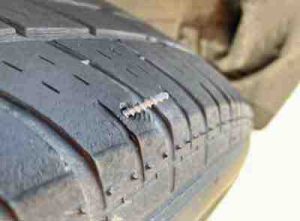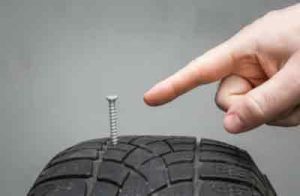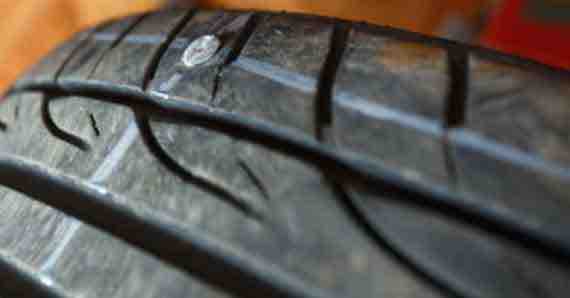Have you ever thought about how long you can drive with a screw in your tire?
Well, the answer to this question varies as the situation with each case of a tire with a screw in it differs.
The time it would take to drive with a screw in your tire is dependent on how long it will take your tire to deflate after having been punctured. Sometimes it could take 15-20 seconds, other times it could last for up to 10-20 minutes to drive with a screw in your tire.
It boils down to how deep the screw lodged into the tire. While some cut deep for larger air passages where the tire immediately goes flat, others just lodge in, almost covering the air passage thereby allowing the car to deflate gradually.
Table of Contents
Driving a screw in your tire: Is it safe?
It is not safe to attempt driving with a screw in your tire. Auto mechanics have warned against this. Driving with a screw in your tire is not only bad but potentially dangerous.
It can even cause a blowout, and when this happens, you are most likely going to lose control of the car which will lead to a possible accident.
And if you happen to survive this by sheer luck, then be sure to be left with a bigger car problem than parking at a safer spot and fixing your tire as you should have earlier done.
Driving on a tire with a screw in it is never safe.
But then, you should know that you only have a borrowed time to look for a safer spot to park for a tire fix. And in doing so, there is the necessity of massive reduction of your driving speed.
This is supposed to take at least 10-15 minutes. It is relative to your driving location when you are faced with such a problem.
It is pretty risky to drive with a screw in your tire, the case can escalate and extensive damage can be caused.
Nonetheless, an essential thing to take note of is the location of the screw in your tire.
Because while a simple tire patch can solve a case of screw lodging in the middle of the tire, just along with the threads, replacement becomes the only viable option.
This is for a case where the screw snaps into the tire shoulder or sides – the car’s weight is rested on the shoulders and sides, as such, patching those areas will sure end in futility.
You can afford a 10-15 minutes drive from having a crew in the middle of your tire. But, screws at the sides or shoulders give you no time as it causes instant car disbalance.
How long will a tire last if there’s a screw in it?
How long a tire lasts with a screw in it boils down to three major factors; the intensity of the screw, the position of the screw on the tire, and the diameter the screw occupies on the tire.
The intensity of a screw in a tire determines the extent of the air rush that will predict how soon disbalance sets in.
There are cases where debris, nail, or screw lodges in tires, almost sealing the punctured space. This case will only cause a slow air leak.
Here the tire can last up to 40-50 minutes before you may even notice a tire air leak.
The position of a screw on the tire also tells how long the tire lasts.
If the screw sets in one the middle of the tire, then there’s much pressure from there to cause instant deflation relative to a case where the screw punctures a tire on the sides of shoulders that bears the car’s weight with much pressure directed there. This case causes instant tire distortion.
If the screw in a tire is above ¼ of an inch (which equals 16 millimeters) then you are sure to have such tire last nothing less than 5 minutes before you begin to experience driving difficulty from your tire’s distortion.
How much will it cost you to remove a screw in your tire?
On average, it will cost you between $10 and $20 to remove a screw from a tire.
Tire puncture repair is not as expensive as many people think. You could even get a free tire fix from some car dealers if you often patronize them and there is a good extent of cordiality established between you and them. But this is just for cases of plugs used in fixing small punctures.
On the other hand, if the screw is on the tire sides or shoulders where there is a high level of flex, then this case will need an entire tire change, and this will cost you $75-80.
There are also cases of punctures from the inside, although it may not need a change of tire, but, it is a bit more work than cases of small punctures.
As such, it will require dismantling and rebalancing of tires. It will cost you up to $30-35.
How do screws get stuck in tires?

Why do I often get screws in my car tire? Is it by sheer happenstance or there are factors that increased the probability of my getting screws in my tires?
I am big on cars, as such, I change cars often. And from my driving experience all the years, I know the factors causing screws to get stuck in car tires.
There was a certain period of time I did not get screws in my tires for more than seven years.
And there was another period also, I got punctured tires for screws digging into them in almost three weeks intervals between a couple of these happenings.
Below is how screws get stuck into your tires:
- Sabotage
- Wooden planks with screws
- Screws on puddles
- Driving over screws
Sabotage
There are times you don’t necessarily need to be in an area where there is a high possibility of screws getting stuck into your car owing to the activities of that environment.
Someone may out of sheer wickedness does you bad. Or probably because you might have had issues with him or her in the past.
In this case, such a person can get a screw lodged into your tires or plant screws in places where you can easily drive on them.
Wooden planks with screws
When a screw is on a wooden plank, it has the stability of staying quite upright. And the screw will penetrate your tire immediately you drive over it.
In cases like this, your car’s weight causes the wood to disintegrate and have the screw further lodge deeply into your tire.
Screws on puddles
You will hardly ever know if there is any screw in puddles when you drive over. This is because, in this scenario, they are underneath the water.
The wavering caused by your tire getting into the puddles might cause these screws to point at angles where they easily get stuck to your tires.
Driving over screws
Obviously, there is no more common way of getting screws in your tire than driving over them. And this mostly affects the rear wheels.
Situations like this mostly involve the screw lying vertically on the ground.
And the front tire immediately flips the screws up by the head and keeps them erect, and as soon as any of the rear tires go over them, the screw gets stuck to the tire immediately.
You can easily get screws stuck in your tires if you drive in an area where:
- Construction works are going on
- Carpentry works are done close by
- A tradesperson has been working in that area and dropping screws
How to protect your tires from nails
If you ever find a helpful way that protects against tire puncture, then you have solved a good part of your car’s problem.
Many car owners often encounter this. However, below are easy ways that will help you out to protect your tire from nails.
- Protect your tires with tire sealants
- Have your tires lined up using puncture-resistant strips
- Have some good punctured-proof tires
- Have your tires on monthly inspection
Protect your tire with tire sealants
Since people discovered the importance of tire sealants on puncture prevention, they have not given a pause.
This is done by the application of the sealants in the tires’ inside when newly purchased.
It is sprayed through the valve cover and fully distributed on the inside while rotating the tires.
Have your tires lined using puncture-resistant strips
Here, you will have to remove the tires from the rim, after which you apply the strips to the inside belt and tires.
Make use of adhesive for a firm attachment between the tires and the strips.
Dramatically, your tires’ durability is on an entirely new level. Sounds incredible, right? But then, it works great.
Have some good puncture-proof tires
The “puncture-proof” tire is a recent innovation. Its reinforced sides are very thick. Its rubber threads are thick as well.
This makes metals, screw nails, and other debris impenetrable. This technology is only available in fewer car tires, and mostly on motorcycles and off-road vehicles.
Have your tires on monthly inspection
The part of your tires that are most vulnerable to punctures are the sides with weak treads and sidewalls.
You’re definitely going to spot these areas soon and do the needful if you constantly have them checked.
And having your tires checked every month is definitely one big effort that will help in no small way to help you with this.
What are the chances of getting a screw in your tire?

The environment contributes hugely to the propensity of getting screws in your tire.
Of course, in good driving areas where there is adequate road maintenance, areas where the roads are always kept clean, one hardly ever hears of a tire puncture.
Nonetheless, this is not to rule out the possibility of schmucks intentionally pouring out debris and other metals materials on roads to satisfy their sheer evil.
But in normal areas, everything being equal, your chances of getting screws in your tires is also dependent on your tires’ quality.
While tires with good quality can easily drive past a road with nails and not get punctured, the same cannot be said for low-quality tires.
This is because the thread and shoulders of these tires get weakened with so much ease.
Underinflated and overinflated tires easily get nails lodged to penetrate them too.
An overinflated tire will easily get screws stuck to it because it is only natural for an excessively stretched and air-filled polymer material to tear, burst or puncture when in contact with a sharper material on the outside.
An underinflated tire too will easily get punctured because a huge part of the tire will be in contact with the ground. As such, by virtue of the possibility of getting a screw in such a tire increases.
Conclusion
The automobile industry is a crucial one. As such, every article that relates to it is written with so much attention paid to veracity and revelation of technical details. I do not undermine that fact.
This is why this article is written on proven principles that have been serving for years to help you glide with much ease through the hurdles that most car owners face on a daily basis.
Do well to follow through and strictly adhere to the guidelines therein as they have been written to serve you. Safe drive!

